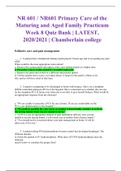Exam (elaborations)
NR 601 / NR601 Primary Care of the Maturing and Aged Family Practicum Week 8 (Ethical Issues and End-of-Life Care) |Grade A| Quiz Bank | LATEST, 2020/2021 | Chamberlain college
- Course
- NR 601 / NR601
- Institution
- Chamberlain College Of Nursing
NR 601 / NR601 Primary Care of the Maturing and Aged Family Practicum Week 8 Quiz Bank | LATEST, 2020/2021 | Chamberlain college Palliative care and pain management ____ 1. A patient had a transdermal fentanyl patch placed 2 hours ago and is not getting any pain relief. What would be the most ap...
[Show more]



